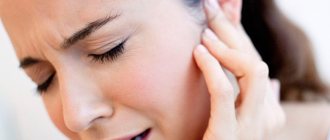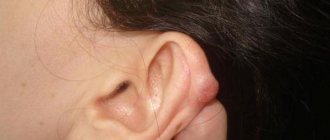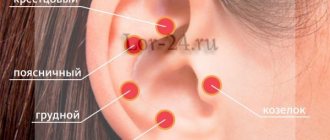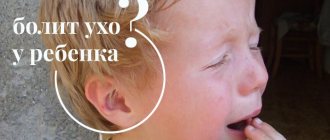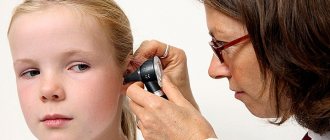Perichondritis is a whole group of diseases based on inflammation of the auricle. An unpleasant painful condition, accompanied by fever, insomnia, and a general painful and depressed state.
This disease of the outer ear develops gradually, at the initial stage the symptoms are not pronounced, even pain does not appear immediately. Typically, a patient thinks about turning to specialists when inflammation of the auricle is already very disturbing, and the first signs of a purulent process are obvious.
The sooner perichondritis is diagnosed and inflammation begins to be eliminated, the more successful the treatment will be.
What is perichondritis?
It all starts with inflammation and redness of the skin, pain occurs in the ear canal, but it is mild. The pathological process affects the outer tissues of the auricle, in the area of cartilage, while the earlobe does not change and remains in its original form.
Redness and inflammation are accompanied by hyperthermia of the integument; as the disease progresses, the ear shell changes. This occurs due to the accumulation of purulent secretion under the skin, as well as the separation of cartilage.
If you do not start treating the disease, if you do not start it in a timely manner, then irreversible changes will begin; they affect the cartilage tissue, leading to deformation of the hearing organ. Such changes cause aesthetic discomfort; they are also potentially dangerous to human life and health.
If we define the disease, we can say that perichondritis is an inflammation of the outer part of the ear, involving cartilage tissue in the pathological process. The disease has several causes and its own, very specific symptoms.
You can determine a person’s illness by his ear
It is a widespread disease that affects all age groups. As a rule, the cause of otitis externa is acute bacterial infections of the skin of the external auditory canal, although the disease can also be non-infectious. It is very painful, although it rarely leads to serious complications or long-term loss of performance. At the same time, patients with diabetes, immunodeficiency conditions, and chronic infection may develop potentially life-threatening malignant external otitis. According to the duration of the course, acute and chronic external otitis are distinguished.
Causes of cartilage inflammation
There are a number of factors that can, to a certain extent, influence the development of the disease. They provoke perichondritis. The list of main causes of the disease includes:
- Various traumatic injuries to the outer part of the auricle.
- Burns, cuts, dissections - in case of untimely treatment and infection.
- Diseases of viral and cold origin, as a result of the development of complications when pathogenic microorganisms with the blood or lymph flow enter the cartilage tissue and cause their inflammation.
- Contact with cold temperatures or frostbite. In this case, the disease progresses quickly, and rapid tissue necrosis begins. To avoid consequences, you will have to start treatment as soon as possible.
- Insect bites. In case of infection of the bite site with pathogenic microorganisms.
These are the main causes of the disease, but in practice, otolaryngologists claim that other factors can lead to the development of inflammation:
- Systemic diseases of the ENT organs significantly increase the risks; inflammation can move from the internal part to the external part;
- surgical interventions performed according to indications, as well as various punctures, incisions and other manipulations increase the risks; if wounds are not treated, you can easily encounter perichondritis.
Inflammation may be a consequence of other disorders in the body. We are talking about diseases of the endocrine system. Thus, diabetes mellitus, metabolic and hormonal imbalances can provoke inflammation, as can a severe allergic reaction.
Forecast
In the absence of appropriate treatment for perichondritis, the following complications are possible:
- purulent melting of soft tissues with the development of purulent perichondritis against the background of serous;
- transition of inflammation to the cartilage of the auricle;
- necrosis of soft tissues and cartilage with subsequent rejection of dead tissue;
- cosmetic defects due to the appearance of a scar at the site of rejected tissue.
With timely treatment, a complete cure is possible without any consequences.
Classification of perichondritis
In otolaryngology, the disease is classified depending on the form of its course. Perichondritis occurs:
Perforation of the eardrum: main symptoms of rupture
| Purulent | In this case, a secretion of a similar (purulent) nature accumulates in the area of the auricle. Because of this, the surface of the organ acquires a characteristic bumpiness. A person is concerned about signs of intoxication, indicating an active inflammatory process in the tissues. The appearance of the ear changes, there is skin hyperthermia and redness. The cause of occurrence is infection with staphylococci, Pseudomonas aeruginosa. |
| Serous | Inflammation is of a nonspecific nature and can occur as a result of an allergic reaction in the event of an infection. The symptoms of the disease are the same: redness of the integument, hyperthermia of the skin, swelling and soreness of the shell, disturbing upon palpation. More often it develops after traumatic damage to cartilage tissue, as a complication of a previously suffered viral disease. |
The disease is also classified according to the form of the pathological process:
| Acute inflammation: | The symptoms are pronounced, but with adequate therapy they quickly go away. If left untreated, it can cause serious complications. |
| Chronic: | The disease occurs in a latent form, the symptoms are mild or bothersome from time to time, with a decrease in the activity of the immune system. It is no less dangerous, since it requires long-term treatment, periodically worries about relapses and can cause serious complications. |
Risk factors for developing perichondritis
As a rule, perichondritis develops due to the penetration of “cocci” into the perichondrium - Staphylococcus aureus and greenish staphylococcus, as well as Pseudomonas aeruginosa. They get into the fabric under the following circumstances:
- Through scratches, scratches and abrasions;
- through a puncture of soft tissue for piercing;
- through insect bites
- through eczema-affected skin areas.
In some cases, pathogenic flora penetrates the perichondrium from neighboring tissues:
- With otitis of the external or middle ear;
- when the body's defenses decrease;
- in case of hypothermia, frostbite or burn;
- after long-term use of antibacterial agents.
To avoid the occurrence of such an unpleasant and dangerous disease as perichondritis of the auricle, you should adhere to certain preventive measures:
Symptoms
The disease has a number of specific signs:
- Redness and hyperthermia of the integument, in the area of cartilage, without damage to the lobe.
- Swelling of the tissue and pain when trying to palpate.
- Pain in the auditory canal area, changes in well-being, increased body temperature, intoxication of the body.
Pay attention to the appearance of the auditory organ; if the ear is red, swollen or swollen, then you should immediately contact an otolaryngologist.
| In the purulent form, concerns: | For serous: |
| Intoxication, fever, sensation of pulsation in the sink area. Changes in the quality of the skin due to the reduction of purulent secretions. | There may be no intoxication, and the temperature may remain within normal limits. But at the same time, the ear is red, swollen, and touching it causes pain. |
It is believed that concha perichondritis is similar in symptoms to erysipelas. But in the first case, soft tissues are not involved in the pathological process, the earlobe remains unchanged.
Erysipelas is often accompanied by severe itching, but only an otolaryngologist can differentiate the disease.
Forms of eczema of the external auditory canals and photos of eczema in the ears
Eczema of the ears is a chronic inflammatory skin disease characterized by erythematous-vesicular, pruritic eruptions. The causes of eczema of the ear canal are extremely varied. They are divided into general and local.
General: neurogenic and psychogenic factors, allergies to certain substances, diseases of internal organs and the endocrine system. Local - contact with certain irritating agents, abrasions when wearing special clothing, infection of the skin during scarification, discharge of purulent contents from the ear, etc.
The disease occurs acutely, then becomes chronic with a tendency to relapse. Eczema is divided into the following forms: true, occupational, microbial and seborrheic.
With true eczema in the acute period, rashes appear on erythematous, slightly swollen skin - microvesicles, which, quickly opening, form a huge number of small point erosions with drops of serous exudate (symptom of “dew”). This is an acute weeping eczema, during which some of the blisters dry out without opening and form crusts, while new blisters appear at the same time. Consequently, the disease is characterized by polymorphism of rashes, when all its pathomorphological elements are located on the surface of the affected skin area - blisters, erythema, erosions, crusts and scales.
Occupational (contact) eczema usually occurs with increased sensitivity to various substances at work.
Look at the photo above:
eczema in the ears caused by contact causes is accompanied by skin rashes on the face, back of the hands, etc.
Microbial eczema occurs as a result of irritation and secondary eczematization of superficial pyoderma, purulent discharge from the ear or nose, etc. The transition from the acute to the chronic form is characterized by a significant decrease in skin hyperemia, the appearance of islands of its normalization in the affected areas, but the eczematous process itself continues sluggishly.
Abortive form of eczema
- eczematid, which is characterized by multiple, less often single, itchy erythematous scaly spots of oval and round shape of various sizes. When they are irritated, a drip of weeping appears. Such rashes can appear as a result of sore throat, acute respiratory and intestinal diseases, and influenza.
Children with exudative-catarrhal diathesis often develop eczema, most often localized in the face and scalp and accompanied by severe exudation and severe itching.
Diagnosis of the disease
Before starting treatment for smart shell perichondritis, the disease is diagnosed. It means:
- visual examination performed by an otolaryngologist;
- collecting anamnesis, interviewing the patient for complaints;
- palpation of the inflamed auditory organ to identify pain.
If this is not enough, the doctor can prescribe specific examinations to the patient that will help him make an accurate diagnosis and select treatment.
Treatment of perichondritis
Therapy takes place in several stages and can have 2 directions. At the initial stage of development of the inflammatory process, drug treatment of the disease is practiced. What are its basic principles:
- Only antibiotics can stop the key signs of the disease. They are prescribed to the patient, and in 2 forms. Otolaryngologists advise applying antibacterial ointments to the auricle, making lotions, and also taking drugs with a broad spectrum of action orally, in the form of tablets.
- Another component of therapy is antiseptics, these are solutions that are used for compresses. Preference is given to Levomycytin alcohol, but another drug can be used. To increase the effectiveness of therapy, they resort to the help of immunostimulants; they will help to quickly cope with the disease and speed up recovery.
- If the inflammation is nonspecific, then other drugs are prescribed, these may be antihistamines, antifungals and corticosteroid medications.
Ear fungus in humans: main symptoms and effective treatment methods for otomycosis
When perichondritis is purulent in nature or has led to the development of complications, surgical intervention is recommended.
Reasons for prescribing surgical treatment of the disease:
- the beginning of necrotic tissue changes;
- severe deformation of the auricle, its wrinkling;
- copious accumulation of purulent secretion.
The operation is done to reduce existing risks; if there are areas of necrosis, they must be removed. When the shell is changed due to accumulations of pus, the doctor makes several incisions, removes the contents and applies sutures.
Types of surgical intervention:
- The doctor makes small incisions on the outer part of the shell, parallel to the contours, the incisions are vertical, which helps to avoid the formation of large scars.
- When the cartilage melts, the doctor makes perpendicular incisions; extensive scars prevent the auricle from wrinkling and prevent its deformation.
- When this is not enough to restore the shape of the auditory organ, plastic surgery is resorted to.
After the operation, the doctor prescribes antibiotics, the average duration of the course is 10 days. At this time, you will have to go to dressings and monitor the dynamics.
When treating perichondritis, preference is given to drugs with a wide spectrum of activity; these are potent antibiotics that can quickly “extinguish” inflammation.
Drugs prescribed by an otolaryngologist for perichondritis:
- Tetracycline, Erythromycin, Oletetrin - in tablet form;
- Polymyxin M ointment, Povidone-iodine. – can be used for external use;
- Lugol's solution - lubricate the ear at the initial stage of inflammation.
To speed up recovery, after stopping inflammation in the tissues, physiotherapy is performed. Warming and UV irradiation are prescribed.
The outside of the ear hurts - causes and treatment
Perichondritis of the ear can be a diffuse inflammatory, but not necessarily infectious, process, and is manifested by diffuse swelling, redness and pain in the auricle, or an abscess between the cartilage and perichondrium. Systemic inflammatory diseases such as vasculitis, such as granulomatosis with polyangiitis, relapsing polychondritis. Because cartilage receives its blood supply from the perichondrium, separation of the perichondrium on both sides of the cartilage can lead to avascular necrosis and deformity of the auricle, a so-called “cauliflower” deformity, in a matter of weeks. Purulent necrosis, often caused by gram-negative bacilli, may also occur. Clinically, this condition is manifested by hyperemia, pain and swelling.
Unconventional methods
They can act as an addition to the main therapy, but are not suitable as the main means of treating the inflammatory process.
What will help eliminate the main signs of the disease:
- You can apply a compress of plantain juice, chamomile infusion and celandine to the damaged surface. The duration of the procedure does not exceed 20 minutes. It is not prohibited to use an alcohol tincture of these herbs; it will have a powerful anti-inflammatory effect.
- You can relieve swelling and remove redness with baking soda. It is diluted with warm water to make a paste. Then apply it to the ear for 15 minutes.
- A decoction of echinacea will help strengthen the immune system and speed up recovery; it is taken in portions throughout the entire period of treatment.
- To eliminate purulent contents, apply aloe juice, baked onions and bread crumbs with salt to the auricle.
But before you begin treatment with such methods, it is worth discussing the feasibility of them with your doctor.
What diseases cause pressure on the ears from the inside - symptoms, causes, treatment
You should not try to cure the disease with traditional methods, deliberately refusing antibiotics. This can lead to serious complications, causing an abscess or sepsis.
Complications and prognosis
At the initial stage of development of the inflammatory process, if you turn to doctors for help in a timely manner, the prognosis is favorable. With the help of antibiotics, pathological processes can be stopped and surgical intervention will not be required.
But if not treated in a timely manner, a person risks facing serious consequences of the disease:
- necrosis will begin in the tissues, the affected areas will have to be removed, which will lead to a change in the appearance of the external knot;
- if the inflammation spreads to the inside of the organ, the person may lose hearing partially or completely.
Since the ear canal has a direct connection to the brain, bacteria can enter it and cause inflammation of the meninges, a disease called meningitis and often causing disability.
Sepsis (blood poisoning) is considered a serious complication of the disease; in this case, it is impossible to predict the effectiveness of treatment. The patient is urgently hospitalized in the intensive care unit.
Prolonged inflammation reduces the chances of a quick cure for the patient. What changes the prognosis for the disease. For this reason, it is so important not to hesitate to see a doctor.
Disease prevention
Measures of this kind will help prevent the development of the disease, but they will not be able to eliminate the likelihood of perichondritis.
As part of prevention, it is recommended:
- Regularly undergo examinations with an otolaryngologist, without missing scheduled visits.
- In case of injury, bite, burn, treat the damaged surface with antiseptics.
- Treat viral and cold-related diseases in a timely manner.
- After piercing or surgery, do not forget that the wounds should be disinfected.
- Do not agree to carry out questionable manipulations in relation to the auricle, in unsanitary conditions.
- Protect your head, including your ears, from exposure to low temperatures, avoid hypothermia, and do not go outside in winter without a hat.
When the first symptoms of the disease appear, you should apply an alcohol compress to the affected area. This is a kind of “first aid” that can prevent the development of complications. But she does not rule out contacting an otolaryngologist, even if the unpleasant symptoms “have subsided.”
Don't forget that you can get an infection accidentally. But if you ignore the symptoms and don’t pay attention to the deterioration of your health, then such an accident can cost a person his life.
Recommended video:
To treat perichondritis of the auricle, various medications are used, and antibiotics and antiseptics are used. But if you consult a doctor too late, you may encounter undesirable consequences of the disease. Deformation of the ear, wrinkling of the shell, necrosis - such complications can have a detrimental effect on a person’s appearance and state of health.
general information
The structural basis of the outer ear is cartilage, covered with perichondrium. The perichondrium is a special tissue that provides nutrition to cartilage, its growth and restoration.
If there is any damage to the perichondrium or penetration of microorganisms into it, the tissue responds to the damaging agent with inflammation. This inflammatory process is called perichondritis of the auricle.
There are two types of perichondritis: serous and purulent. This form was first described at the end of the 19th century. Italian otolaryngologist Giuseppe Gradenigo.
Purulent perichondritis is considered a more severe disease. It is accompanied by purulent melting of surrounding tissues, including the cartilage itself, and is often a complication of serous.
